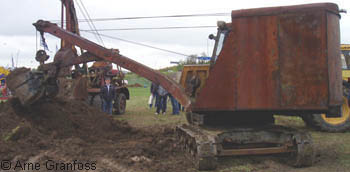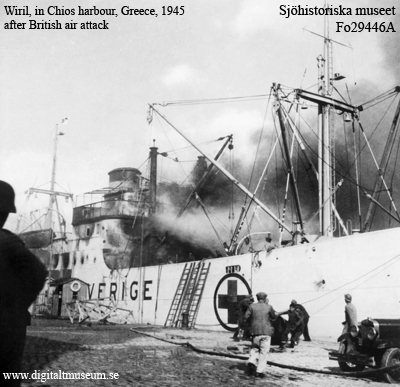Swedish aid to Europe

 UNDER CONSTRUCTION Version 0.4
UNDER CONSTRUCTION Version 0.4
|
Sweden in World War II - across borders
|
 |
![]()
![]()
In 1942 Greece suffered from famine, and Sweden organized transports with corn/grain.
The Netherlands received similar aid from Sweden. [s28]
![]()
After the German occupation of Greece, also this country had to send food to Germany. (Also when the 1941 harvest was poor. During the cold winter in Europe 1941-1942 people began to die from starvation. During six months 50,000 deaths were registred in Athens and Pireus alone.) The Swiss Red Cross representative in Athens had sent out an alarm. Canada was willing to send corn to Greece, and financial support was given from the U.S.A. (both government and organisations). [s64]
The Swiss contacted the Swedish government, and volunteers designated a number of Swedish ships for transports to Greece. The crews were foremost Swedes. The warfaring parts granted a safe conduct for these Swedish ships, that should be marked as the Swedish ships in the permitted "lejdtrafiken" to and from Sweden - with among others the name "Sverige" and Swedish flags painted on the sides and deck and good illumination when it was dark. These ships also had large red cross symbols. [s64]
The first Swedish ship arrived in May 1941, with 5,000 metric tonnes of wheat that was transported from Lissabon. The ship also brought packages from Sweden, the results from subscriptions. [s64]
For 1942 Britain, Germany and Italy granted a safe conduct for nine Swedish ships, and for 1943 for another five ships. The quantity then was 24,000 metric tonnes per month to Greece. Smaller Swedish ships regularly delivered food from Athens to the islands Crete, Rhodes and other islands. [s64]
Stureborg sailed for the International Red cross. She was sunk by bombs on 9 June 1942, on the way from Pireus to Haifa. [s73]

Swedish ships were used also for other Red Cross aid transports in the Mediterranean Sea, for example between Portugal and southern France. [s64]
The traffic continued in 1944. Four ships were sunk when they sailed in this traffic, by bombs, mines or torpedo. 700.000 metric tonnes of food and medicin had been transported. [s64]
Swedish Red Cross ship Wiril burning after a bomb attack in Chios harbour in Greece. [s73] (Another source tells that she was bombed on 7 February 1944 - was she bombed twice?) (Read more about Wiril's long voyage on the page "Bombs on Sweden" - same photo there.)

![]()
The Danish, Swedish and Swiss Red Cross were later during the war allowed to send relief parcels to Scandinavian prisoners in German prison camps. [s67]
![]()
During the German advance towards France in 1940, the British channel islands were occupied. Some 100,000 people lived in the area, mainly on Alderney, Guernsey, Jersey and Sark. [s64]
![]()
As the Allies landed in Normandie on 6 June 1944, no attempts were made to liberate these islands. There still were some 20,000 German soldiers in the area. In the autumn of 1944 the British government got a serious message from the islands about their bad food situation. [s64]
The harbours on the islands were shallow, and the small Swedish s/s Vega was chosen for these aid transports. The first shipment from the Red Cross stores in Lissabon in Portugal was unloaded on 12 December 1944. Vega made four more trips to the Channel Islands, each trip permitted by the Allies and the Germans in advance. Vega sailed well illuminated as other Swedish ships in the so called granted "lejdtrafiken", and she had Red Cross symbols. She was not attacked. [s64]
Harbour workers were so hungry that they ate flour from the sacks. [s65]
In 1970 Jersey isued a stamp with Vega. [s64]
Vega had earlier sailed among others between Lissabon and Marseille with supplies to British war prisoners in Germany. [s65]
![]()
In early 1945 three illuminated ships sailed southwards along the Swedish eastcoast, with Red Cross symbols. They were on the way to the Netherlands, with among others flour and herring from Sweden. The ships had radio, so that their positions could be transmitted to both the Allies and the Germans. When they arrived at the Kiel Channel the Germans wanted them to turn off their lights, so that British bombers couldn't use it for navigation. The Swedes refused. In Delfzijl the cargo was taken aboard channel barges for further transport. The Swedish ships made three trips to the Netherlands. [s65]
![]()
On 10 April 1945 the Swedish ship m/s Gotland left Göteborg, with a Red Cross delegate onboard. With cargo loaded in Britain on 5 May she left for the Netherlands, and in a convoy with British utility ships she reached Rotterdam on 17 May. Back to Britain on 28 May, in company with the Swedish ship Karmas. Karmas then sailed to Gibraltar. On 5 June m/s Gotland sailed in a convoy of 13 ship across the North Sea, in a marked mine-swept corridor. The ship was back in Göteborg on 8 June 1945. [s64]
![]()
Felix Kersten, a masseur with a good reputation, had Himmler as patient from March 1939. In the autumn of 1943 he moved to Stockholm in Sweden, with Himmler as a patient until April 1945. He had several discreet contacts with officials from among others Sweden, and had over the years managed to persuade Himmler to release many prisoners. He among others arranged a secret meeting near Berlin on 20 April 1945 between Himmler and Norbert Masur from the Jewish congretation in Stockholm, at this meeting as representative for the World Jewish Congress, to discuss the release of Jews from German camps. Himmler agreed to release 1,000 Polish women from Ravensbrück, and from the same camp a number of French women according to a list made by the Swedish foreign office. Also to release a larger number of Dutch Jews from Theresienstadt. 50 Jews from camps in Norway should be released and transported to the border to Sweden, and a number of Norwegians held as hostages might also be released. [s67]
![]()
In May 1945 Swedish ships transported thousands of former prisoners in German camps to Sweden, in the UNNRA operation. [s67]
![]()
Some 40 Swedish ships had sailed for the Red Cross during WWII, foremost in the traffic with necessities from Canada and the U.S.A. to Greece. Besides exchange of prisoners between warfaring countries and similar transports, they also were used for aid to Belgium, Holland and the British Channel Islands. [s65]
![]()
Approximate numbers of foreigners in Sweden on 1 December 1944:
Refugees:
Denmark 15,000 - Finland 6,000 - Norway 30,000 - Estonian-Swedish 6,500 - Baltic countries, others 25,000
Belgium 110 - Germany 5,400 - France 540 - Netherlands 560 - Poland 1,100
Soviet Union 200 (1,000 had been sent home) - Yugoslavia 110 - Other countries 1,000
Finnish evacuees 38,000 - Finnish children 45,000
Other foreigners: 11,000
Totally around 185,500.
2015-08-29. www.granfoss.se. Text/pictures: Arne Granfoss